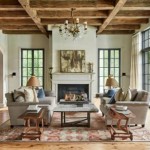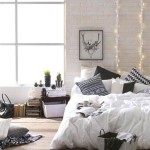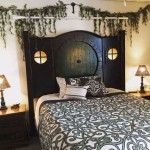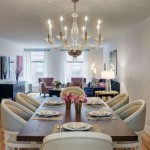Gypsy Living Room Decor: A Guide to Creating a Bohemian Sanctuary
Gypsy living room decor, often synonymous with bohemian style, aims to cultivate a space that is free-spirited, eclectic, and deeply personal. It emphasizes comfort, artistic expression, and a sense of global influence. Achieving this aesthetic involves layering textures, incorporating vibrant colors, and curating a collection of unique objects that tell a story. The essence of gypsy decor lies in its ability to transform a living room into a welcoming, expressive haven, reflecting the individual's journey and passions.
The term "gypsy" itself is historically complex and can be considered insensitive by some. This article uses it as a descriptor for a specific decor style commonly associated with bohemian aesthetics, recognizing the importance of sensitivity and avoiding perpetuation of harmful stereotypes. The focus remains on the decorative elements and principles that characterize this style, regardless of its potentially problematic historical associations.
Color Palette and Pattern Mixing
Color is a cornerstone of gypsy living room decor. It avoids the stark minimalism often found in contemporary design, opting instead for a rich and varied palette. Deep jewel tones like emerald green, sapphire blue, ruby red, and amethyst purple form the base, creating a sense of opulence and depth. Earthy tones such as terracotta, ochre, and brown provide grounding and warmth. These colors are frequently used in combination, rather than in isolation, to create a vibrant and stimulating visual environment.
Pattern mixing is another defining characteristic. A successful gypsy living room integrates a variety of patterns, often from different cultural origins. Think of Persian rugs layered over jute carpets, ikat cushions scattered on velvet sofas, and geometric prints juxtaposed with floral tapestries. The key to effective pattern mixing is to find a common thread, such as a shared color or motif, that ties the disparate elements together. Scale is also important; varying the size of the patterns prevents them from overwhelming the space. The deliberate combination of diverse patterns creates an atmosphere of global exploration and artistic freedom.
The use of metallics plays a significant role in enhancing the color palette. Gold, silver, and bronze accents can be incorporated through lamps, picture frames, decorative trays, and even metallic threads woven into fabrics. These metallic elements add a touch of glamour and reflect light, creating visual interest and enhancing the overall ambiance. Brass candlesticks, ornate mirrors with gold frames, and cushions embroidered with metallic threads are all common elements that contribute to the luxurious feel of a gypsy-inspired living room.
Textural Layering and Fabric Selection
Texture is paramount in achieving the desired comfort and visual depth in a gypsy living room. The aim is to engage the senses through a variety of tactile experiences. Soft, plush fabrics like velvet, silk, and faux fur are juxtaposed with coarser materials such as jute, linen, and macrame. This creates a dynamic interplay of textures that invites touch and encourages relaxation.
Rugs are essential for defining the space and adding warmth underfoot. Layering rugs of different sizes, textures, and patterns creates a bohemian effect. A large Persian rug can serve as the foundation, with smaller kilim rugs or sheepskins layered on top. This not only adds visual interest but also creates distinct zones within the living room. Consider using textured rugs made from natural fibers such as sisal or seagrass to add an earthy, grounding element to the space.
Cushions and throws are indispensable for creating a comfortable and inviting seating area. A generous assortment of cushions in various shapes, sizes, and textures should adorn sofas and armchairs. Velvet cushions, embroidered cushions, and cushions with tassels or fringe are all popular choices. Similarly, throws made from soft materials like wool, cashmere, or faux fur can be draped over furniture to add warmth and visual appeal. Intricate patterns and embellishments on throws can further enhance the bohemian aesthetic.
The use of tapestries and wall hangings is another effective way to introduce texture and pattern into the living room. Macrame wall hangings, woven textiles, and vintage scarves can be displayed to add visual interest and create a focal point. These elements contribute to the overall sense of bohemian artistry and individuality. They also offer an opportunity to personalize the space with objects that hold personal significance.
Furniture and Decorative Objects: Eclecticism and Personal Expression
The furniture in a gypsy living room should reflect a sense of eclecticism and individuality. Instead of matching sets, opt for a curated collection of pieces from different eras and styles. Vintage furniture, antique finds, and handcrafted items are all welcome additions. The key is to choose pieces that have character and tell a story.
Low-slung seating is a common feature of gypsy decor. Floor cushions, poufs, and low sofas create a relaxed and informal atmosphere. Moroccan poufs, in particular, are a popular choice for adding a touch of exotic flair. These seating options encourage lounging and create a sense of intimacy within the living room. The placement of seating should promote conversation and create a welcoming environment for guests.
Decorative objects play a crucial role in personalizing the space and reflecting the individual's interests and experiences. This is where personal collections, travel souvenirs, and handcrafted items take center stage. Displaying these objects in a thoughtful and intentional manner adds character and creates a sense of lived-in authenticity.
Plants are an integral part of gypsy living room decor, bringing life and vibrancy to the space. A variety of plants, both large and small, can be incorporated to create a lush and inviting atmosphere. Hanging plants, potted plants, and even dried floral arrangements can be used to add a touch of nature to the interior. Plants not only purify the air but also contribute to the overall sense of well-being and relaxation within the living room. Plants in macrame hangers fit perfectly with the overall decor.
Lighting should be soft and ambient, creating a warm and inviting atmosphere. String lights, lanterns, and candles can be used to create a magical ambiance. Fairy lights strung across the ceiling or draped around furniture add a whimsical touch. Candles in various sizes and scents can be placed throughout the room to create a relaxing and inviting environment. Opt for lamps with warm-toned bulbs to avoid harsh lighting and create a cozy atmosphere.
Mirrors are essential for expanding the space and reflecting light. Ornate mirrors with antique frames can be strategically placed to create the illusion of more space and add a touch of glamour. Grouping smaller mirrors together can create a gallery wall effect and add visual interest. Mirrors with interesting shapes and textures can also be used to enhance the overall aesthetic of the room.
Ultimately, a gypsy living room is a reflection of the individual's personality and style. There are no hard and fast rules; the most important thing is to create a space that feels comfortable, inviting, and authentic. The blending of colors, textures, patterns, and personal objects contributes to a unique and expressive environment.

Maximalist Bohemian Rooms I D Copy Right Now Funky Fabulous Spaces Firefly Finch

Pin On Diy Home

Bohemian Style Room Decor Ideas For Your Home Spacejoy

Bohemian Style Room Decor Ideas For Your Home Spacejoy

Go East For Boho Inspired Home Decor Betterdecorating

How To Give Gypsy Look Bedroom Decor Royal Furnish

Autumn Inspired Bohemian Home Decor Chic Hippie Modern Living Room

85 Inspiring Bohemian Living Room Designs Digsdigs

25 Boho Living Room Decor Ideas That Rock Shelterness

Eye For Design Decorating Gypsy Chic Style
Related Posts







